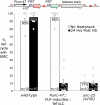Gene activation using FLP recombinase in C. elegans
- PMID: 18369447
- PMCID: PMC2265415
- DOI: 10.1371/journal.pgen.1000028
Gene activation using FLP recombinase in C. elegans
Abstract
The FLP enzyme catalyzes recombination between specific target sequences in DNA. Here we use FLP to temporally and spatially control gene expression in the nematode C. elegans. Transcription is blocked by the presence of an "off cassette" between the promoter and the coding region of the desired product. The "off cassette" is composed of a transcriptional terminator flanked by FLP recognition targets (FRT). This sequence can be excised by FLP recombinase to bring together the promoter and the coding region. We have introduced two fluorescent reporters into the system: a red reporter for promoter activity prior to FLP expression and a green reporter for expression of the gene of interest after FLP expression. The constructs are designed using the multisite Gateway system, so that promoters and coding regions can be quickly mixed and matched. We demonstrate that heat-shock-driven FLP recombinase adds temporal control on top of tissue specific expression provided by the transgene promoter. In addition, the temporal switch is permanent, rather than acute, as is usually the case for heat-shock driven transgenes. Finally, FLP expression can be driven by a tissue specific promoter to provide expression in a subset of cells that can only be addressed as the intersection of two available promoters. As a test of the system, we have driven the light chain of tetanus toxin, a protease that cleaves the synaptic vesicle protein synaptobrevin. We show that we can use this to inactivate synaptic transmission in all neurons or a subset of neurons in a FLP-dependent manner.
Conflict of interest statement
The authors have declared that no competing interests exist.
Figures




References
-
- Zhang S, Ma C, Chalfie M. Combinatorial marking of cells and organelles with reconstituted fluorescent proteins. Cell. 2004;119:137–144. - PubMed
-
- Drake J, Link CD, Butterfield DA. Oxidative stress precedes fibrillar deposition of Alzheimer's disease amyloid beta-peptide (1-42) in a transgenic Caenorhabditis elegans model. Neurobiol Aging. 2003;24:415–420. - PubMed
-
- Buenzow DE, Holmgren R. Expression of the Drosophila gooseberry locus defines a subset of neuroblast lineages in the central nervous system. Dev Biol. 1995;170:338–349. - PubMed
Publication types
MeSH terms
Substances
Grants and funding
LinkOut - more resources
Full Text Sources
Other Literature Sources
Research Materials

